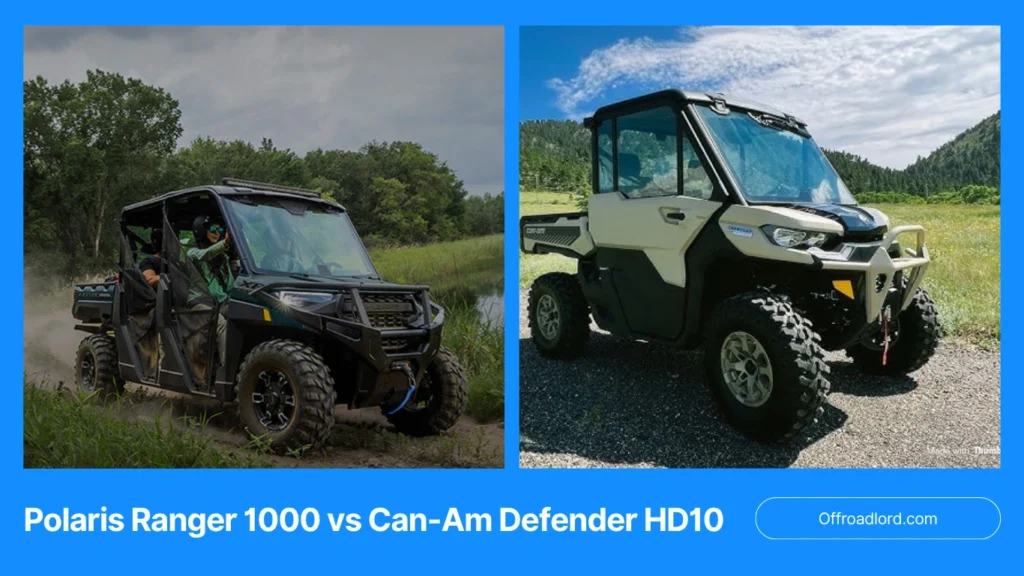Bottom-line
I pick by job and budget.
If you want more power and HVAC options, the Defender HD10 wins. It makes 82 hp, tows 2,500 lb, and carries 1,000 lb in the bed. It sits wider and a bit taller, which helps on ruts but not on narrow gates.
If you want the best value and tight-gate fit, the Ranger 1000 is my move. 61 hp, 62.5 in wide, 2,500 lb tow, 1,000 lb bed, and a 200-hour / 2,000-mile service cadence that keeps downtime low.
Comparison table — Polaris Ranger 1000 vs Can-Am Defender HD10

| Model (3-seat) | Engine / HP | Torque | Transmission | Width | Ground clearance | Suspension travel (F/R) | Seats | Bed L×W×H | Bed rating | Payload | Towing | Est. dry wt | Service interval | Warranty note | MSRP context | Best for |
|---|---|---|---|---|---|---|---|---|---|---|---|---|---|---|---|---|
| Polaris Ranger 1000 EPS | 999 cc twin / 61 hp | Not listed by OEM | Gen 2 Automatic PVT | 62.5 in | 12 in | 10 / 10 in | 3 | 36.75 × 54 × 11.5 in | 1,000 lb | 1,500 lb | 2,500 lb | 1,485 lb | 200 hr / 2,000 mi (owner’s manual) | 2-year limited for 2025 full-size lineup | Starts $13,999 (Ranger 1000) | Narrower trails, tight job sites, lower entry price |
| Can-Am Defender XT HD10 | 976 cc V-twin / 82 hp | 69 lb-ft | PRO-TORQ CVT with QRS | 64 in | 13 in | 11 / 11 in | 3 | 38 × 54.5 × 12 in (website) | 1,000 lb | 1,500 lb | 2,500 lb | 1,623 lb | Per operator’s guide; typical oil at ~100 hr, many items at 200 hr+ (see BRP maintenance hub) | 1-year BRP limited warranty (factory) | XT starts $16,399 (HD10 trim) | More power, wider stance, plush ride on rough ranch roads |
Quick differences that matter
- Power: Ranger 1000 makes 61 hp. Defender HD10 makes 82 hp and 69 lb-ft. The Can-Am pulls longer grades easier and feels stronger with heavy loads.
- Width and clearance: Ranger 1000 is 62.5 in wide with 12–12.5 in of clearance. Typical HD10 trims are ~65 in with 13–14 in of clearance. Narrow gates favor the Ranger. Taller ruts favor the HD10.
- Capacities: Both rate 2,500 lb tow and 1,000 lb bed. Bed size is similar: Ranger 36.75×54×11.5 in, Defender ~38×54.5×12 in.
- Service cadence: Ranger 1000 follows 200 hours / 2,000 miles / 6 months for oil after break-in. Plan severe use at 50% of that. Can-Am follows its operator guide per trim.
- Drivetrain aids: Ranger 1000 uses On-Demand True AWD with Turf Mode. Defender trims range from Visco-Lok auto-locking to Smart-Lok on select packages. Pick based on your surfaces and traction needs.
Engine feel and drivability
I notice the power gap most with a trailer on a hill. The HD10’s 82 hp / 69 lb-ft Rotax V-twin holds speed better and needs less throttle to get moving. The Ranger 1000’s 61 hp single-overhead-cam twin is smoother at low rpm than its spec suggests, but it will downshift sooner and work harder on long grades.
On loose ground, I use AWD on both. The Ranger’s Turf Mode is great on lawns and barns, but I switch out of it for hills or uneven ground. That matches Polaris guidance. On Defender, base trims use Visco-Lok auto-locking; X-packages and Limiteds can add Smart-Lok, which gives selectable modes and a full lock when needed.
Transmission and shifting
Both run belt CVTs. The Ranger 1000 uses Gen 2 Automatic PVT with AWD/2WD/Turf modes. The Defender HD10 uses PRO-TORQ CVT with QRS calibrations and a brake-holding mechanism on many trims that helps during stops on slopes. For slow towing and backing hay wagons, both creep well once the belt is warm and the throttle is steady.
Size, seating, storage, and cab
If you squeeze through 63 in gates, the Ranger’s 62.5 in width helps. The Defender sits about 65 in wide on many HD10 trims. Ground clearance is 12–12.5 in on Ranger vs 13–14 in depending on Defender trim. Benches seat three on both. Bed boxes are close in size, with the Ranger slightly shorter in height. If you need heat and A/C, the Defender Limited ships with a full glass windshield and wiper/washer plus HVAC from the factory.
Towing, plowing, and farm chores
Both are rated to tow 2,500 lb with a 1,000 lb box, which covers most ranch trailers, portable sprayers, and fencing gear.
If you truly need 3,000 lb on the hitch regularly, the Defender 6×6 HD10 is the factory step up. For snow, both platforms support plow setups and receiver-mount winches; I pick based on my dealer’s install support and parts stock.
Ride comfort and steering
Both steer light with power steering. The Ranger 1000 runs sealed suspension bushings that cut squeaks and help the cab stay quieter over time. That matters on long days.
On the Defender HD10, trims list a brake-holding mechanism that keeps you planted on hills. Helpful when you stop on a slope with a trailer.
Maintenance and uptime
Polaris tells you to change oil and filter every 200 hours / 2,000 miles / 6 months after break-in. Severe use cuts that to 50%. That keeps the Ranger 1000 in the field longer with fewer shop visits.
Can-Am posts its service timing in the operator’s guide for each HD10 trim. Follow the guide for your exact model and hours.
Pricing and trims (MSRP snapshot)
- Ranger 1000 line: Starting at $13,999 US MSRP. Prices and fees vary by dealer.
- Defender line: Starting at $12,899 US MSRP for base. The Defender XT shows $16,399 starting on Can-Am’s page. Dealer quotes on Limited and special trims vary.
Which to choose
- Narrow gates, tight barn aisles, lower buy-in: Ranger 1000. It is 62.5 in wide and starts lower in price.
- Power for long grades and heavy loads: Defender HD10. 82 hp and 69 lb-ft feel stronger with a trailer.
- HVAC from the factory: Defender Limited. You get heat, A/C, glass windshield, and wiper.
- Longest time between services: Ranger 1000 with the 200-hour cadence. Use severe-use timing if you tow in heat or live in dust.
- Need 3,000 lb tow from the factory: Defender 6×6 HD10.
Owners report
I watch a few items on every Ranger 1000 I set up for friends: belt condition, airbox seal, brake pressure switch, and radiator fins. Simple checks prevent most headaches.
On Defender HD10, owners talk about keeping the CVT intake clear, greasing pivots on time, and matching tires to the job so steering stays light. If it touches brakes or fuel, I let the dealer handle it.
Accessories that solve real jobs
- Ranger path: side mirrors, glass or hard-coated poly windshield, winch line upgrade, plow kit with mount, spare belt and tool.
- Defender path: mirrors, wiper kit support on cab models, 2-inch hitch and wiring, spare belt and tool, spray-in bed mat.
FAQs
Q: Is the Ranger 1000 underpowered next to HD10?
A: For hills and heavy trailers, yes. Ranger 1000 is 61 hp. Defender HD10 is 82 hp and 69 lb-ft. For chores on flat ground, the Ranger does fine.
Q: Does the 200-hour service really apply to the base Ranger 1000?
A: Yes. After break-in, Polaris calls for 200 hours / 2,000 miles / 6 months for oil and filter. Cut that in half for severe use.
Q: Will a Defender HD10 fit my 63 in gate?
A: Usually no. Many HD10 trims are about 64–65 in wide. The Ranger 1000 is 62.5 in and fits most 63 in gates.
Q: Which has better cab sealing in dust today?
A: Both improved. The Defender Limited ships with factory HVAC, glass, and wiper. A Ranger 1000 with the full cab kit and fresh seals filters well. Keep filters clean on either.
Q: Can I tow 3,000 lb with either 3-seat rig?
A: No. Both rate 2,500 lb. The step up is the Defender 6×6 HD10 at 3,000 lb.
Sources (primary)
- Polaris — Ranger 1000 model specs and dimensions (width, tow, bed, travel).
- Polaris — Ranger owner’s maintenance guidance (200-hour / 2,000-mile cadence after break-in).
- Polaris — 2025 full-size Ranger warranty announcement.
- Can-Am — Defender HD10 platform specs (hp, torque, width, clearance, travel, tow, bed).
- Can-Am — Defender XT/ Limited / 6×6 HD10 trim spec sheets and operator’s guides.

Calvin Anderson, founder of Off-Road Lord, is a seasoned off-roading enthusiast from Tucson, Arizona. With over a decade of hands-on experience and a deep understanding of off-roading vehicles and trails, Calvin’s insights provide a trusted guide for fellow adventurers.